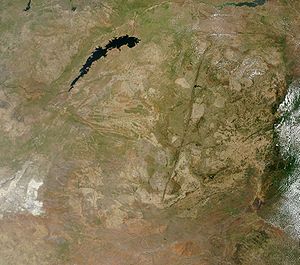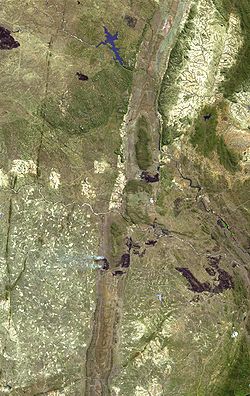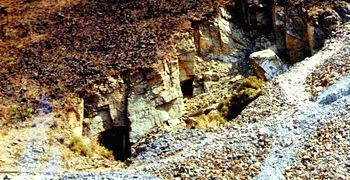
Great Dyke
Encyclopedia

Zimbabwe
Zimbabwe is a landlocked country located in the southern part of the African continent, between the Zambezi and Limpopo rivers. It is bordered by South Africa to the south, Botswana to the southwest, Zambia and a tip of Namibia to the northwest and Mozambique to the east. Zimbabwe has three...
passing just to the west of the capital, Harare
Harare
Harare before 1982 known as Salisbury) is the largest city and capital of Zimbabwe. It has an estimated population of 1,600,000, with 2,800,000 in its metropolitan area . Administratively, Harare is an independent city equivalent to a province. It is Zimbabwe's largest city and its...
. It consists of a band of short, narrow ridges and hills spanning for approximately 550 kilometres (341.8 mi). The hills become taller as the range goes north, and reach up to 460 metres (1,509.2 ft) above the Mvurwi Range. The range is host to vast ore
Ore
An ore is a type of rock that contains minerals with important elements including metals. The ores are extracted through mining; these are then refined to extract the valuable element....
deposits, including gold
Gold
Gold is a chemical element with the symbol Au and an atomic number of 79. Gold is a dense, soft, shiny, malleable and ductile metal. Pure gold has a bright yellow color and luster traditionally considered attractive, which it maintains without oxidizing in air or water. Chemically, gold is a...
, silver
Silver
Silver is a metallic chemical element with the chemical symbol Ag and atomic number 47. A soft, white, lustrous transition metal, it has the highest electrical conductivity of any element and the highest thermal conductivity of any metal...
, chromium
Chromium
Chromium is a chemical element which has the symbol Cr and atomic number 24. It is the first element in Group 6. It is a steely-gray, lustrous, hard metal that takes a high polish and has a high melting point. It is also odorless, tasteless, and malleable...
, platinum
Platinum
Platinum is a chemical element with the chemical symbol Pt and an atomic number of 78. Its name is derived from the Spanish term platina del Pinto, which is literally translated into "little silver of the Pinto River." It is a dense, malleable, ductile, precious, gray-white transition metal...
, nickel
Nickel
Nickel is a chemical element with the chemical symbol Ni and atomic number 28. It is a silvery-white lustrous metal with a slight golden tinge. Nickel belongs to the transition metals and is hard and ductile...
and asbestos
Asbestos
Asbestos is a set of six naturally occurring silicate minerals used commercially for their desirable physical properties. They all have in common their eponymous, asbestiform habit: long, thin fibrous crystals...
.
| Northern end | 16°27′51"S 31°08′24"E |
| Southern end | 20°50′22"S 29°39′04"E |
Geology

Dike (geology)
A dike or dyke in geology is a type of sheet intrusion referring to any geologic body that cuts discordantly across* planar wall rock structures, such as bedding or foliation...
, but is lopolith
Lopolith
A lopolith is a large igneous intrusion which is lenticular in shape with a depressed central region. Lopoliths are generally concordant with the intruded strata with dike or funnel-shaped feeder bodies below the body...
ic and Y-shaped in cross-section. It is a group of layered ultramafic intrusions that extend across Zimbabwe with a strike
Strike and dip
Strike and dip refer to the orientation or attitude of a geologic feature. The strike line of a bed, fault, or other planar feature is a line representing the intersection of that feature with a horizontal plane. On a geologic map, this is represented with a short straight line segment oriented...
of about N10°E. The width of the intrusions vary from 3 to 12 km (7.5 mi). The Great Dyke is unusual in that most ultramafic layered intrusions display near horizontal sill
Sill (geology)
In geology, a sill is a tabular sheet intrusion that has intruded between older layers of sedimentary rock, beds of volcanic lava or tuff, or even along the direction of foliation in metamorphic rock. The term sill is synonymous with concordant intrusive sheet...
or sheet forms.
The well-layered lower units of ultramafic rocks comprising the Great Dyke are locally overlain by erosional remnants of gabbroic rock
Gabbro
Gabbro refers to a large group of dark, coarse-grained, intrusive mafic igneous rocks chemically equivalent to basalt. The rocks are plutonic, formed when molten magma is trapped beneath the Earth's surface and cools into a crystalline mass....
. These mark the centres of the four sub-chambers within the Great Dyke magma system, namely (from north to south) Musengezi, Darwendale, Sebakwe and Wedza. Each of these sub-chambers has an elongate, doubly plunging synclinal
Syncline
In structural geology, a syncline is a fold, with younger layers closer to the center of the structure. A synclinorium is a large syncline with superimposed smaller folds. Synclines are typically a downward fold, termed a synformal syncline In structural geology, a syncline is a fold, with younger...
structure, and was fed by a feeder dyke continuous below almost the entire Great Dyke. Stratigraphically
Stratigraphy
Stratigraphy, a branch of geology, studies rock layers and layering . It is primarily used in the study of sedimentary and layered volcanic rocks....
each sub-chamber is divided into a lower Ultramafic Sequence of dunite
Dunite
Dunite is an igneous, plutonic rock, of ultramafic composition, with coarse-grained or phaneritic texture. The mineral assemblage is greater than 90% olivine, with minor amounts of other minerals such as pyroxene, chromite and pyrope. Dunite is the olivine-rich end-member of the peridotite group...
s, harzburgite
Harzburgite
The ultramafic igneous rock, harzburgite, is a variety of peridotite consisting mostly of the two minerals, olivine and low-calcium pyroxene ; it is named for occurrences in the Harz Mountains of Germany. It commonly contains a few percent chromium-rich spinel as an accessory mineral...
s, olivine
Olivine
The mineral olivine is a magnesium iron silicate with the formula 2SiO4. It is a common mineral in the Earth's subsurface but weathers quickly on the surface....
bronzitites and pyroxenite
Pyroxenite
Pyroxenite is an ultramafic igneous rock consisting essentially of minerals of the pyroxene group, such as augite and diopside, hypersthene, bronzite or enstatite. They are classified into clinopyroxenites, orthopyroxenites, and the websterites which contain both pyroxenes...
s together with narrow layers of chromitite
Chromitite
Chromitite is an igneous cumulate rock composed mostly of the mineral chromite. It is found in layered intrusions such as the Bushveld Igneous Complex in South Africa and the Stillwater igneous complex in Montana.-References:...
that constitute the bases of cyclic units and that are extensively mined along the Great Dyke, and an upper Mafic Sequence mainly consisting of a variety of plagioclase
Plagioclase
Plagioclase is an important series of tectosilicate minerals within the feldspar family. Rather than referring to a particular mineral with a specific chemical composition, plagioclase is a solid solution series, more properly known as the plagioclase feldspar series...
-rich rocks, such as norite
Norite
Norite is a mafic intrusive igneous rock composed largely of the calcium-rich plagioclase labradorite and hypersthene with olivine. Norite is essentially indistinguishable from gabbro without thin section study under the petrographic microscope...
s, gabbronorites and olivine gabbros.
The dyke lies within the Zimbabwe craton
Zimbabwe craton
The Zimbabwe craton is an area in Southern Africa of ancient continental crust and an example of Early Archaean lithology dating back to 3.5 billion years ago in the southern African nation of Zimbabwe. Late Archean metamorphism joined the Southern Marginal Zone of the Kaapvaal craton to the...
and has been dated at 2.575 billion years old. The Great Dyke acts as a strain-marker for the craton: The fact that it has been undeformed since intrusion (excluding the Musengezi area) shows that the craton
Craton
A craton is an old and stable part of the continental lithosphere. Having often survived cycles of merging and rifting of continents, cratons are generally found in the interiors of tectonic plates. They are characteristically composed of ancient crystalline basement rock, which may be covered by...
had stabilised by the time the Dyke intruded.
Two mafic
Mafic
Mafic is an adjective describing a silicate mineral or rock that is rich in magnesium and iron; the term is a portmanteau of the words "magnesium" and "ferric". Most mafic minerals are dark in color and the relative density is greater than 3. Common rock-forming mafic minerals include olivine,...
dykes, the East and Umvimeela, flank the Great Dyke to the east and west respectively. Volcanic surface manifestation of the Great Dyke intrusion have not been recorded and have probably been eroded
Erosion
Erosion is when materials are removed from the surface and changed into something else. It only works by hydraulic actions and transport of solids in the natural environment, and leads to the deposition of these materials elsewhere...
.
The Great Dyke is a strategic economic resource with significant quantities of chrome and platinum. Chromite
Chromite
Chromite is an iron chromium oxide: FeCr2O4. It is an oxide mineral belonging to the spinel group. Magnesium can substitute for iron in variable amounts as it forms a solid solution with magnesiochromite ; substitution of aluminium occurs leading to hercynite .-Occurrence:Chromite is found in...
occurs to the base of the Ultramafic Sequence and is mined throughout the dyke. Below the Ultramafic-Mafic sequences' contact, and in the uppermost pyroxenite (bronzitite and websterite) units are economic concentrations of nickel
Nickel
Nickel is a chemical element with the chemical symbol Ni and atomic number 28. It is a silvery-white lustrous metal with a slight golden tinge. Nickel belongs to the transition metals and is hard and ductile...
, copper
Copper
Copper is a chemical element with the symbol Cu and atomic number 29. It is a ductile metal with very high thermal and electrical conductivity. Pure copper is soft and malleable; an exposed surface has a reddish-orange tarnish...
, cobalt
Cobalt
Cobalt is a chemical element with symbol Co and atomic number 27. It is found naturally only in chemically combined form. The free element, produced by reductive smelting, is a hard, lustrous, silver-gray metal....
, gold
Gold
Gold is a chemical element with the symbol Au and an atomic number of 79. Gold is a dense, soft, shiny, malleable and ductile metal. Pure gold has a bright yellow color and luster traditionally considered attractive, which it maintains without oxidizing in air or water. Chemically, gold is a...
, and platinum group metals (PGM). The base metals occur as disseminated inter-cumulus Fe-Ni-Cu sulfides within an interval referred to as the base metal subzone, below which is a sublayer enriched in platinum group metals called the PGE subzone. The base metal and PGE subzones together, make up the Main Sulphide Zone (MSZ).
Development

Karl Mauch
Karl Gottlieb Mauch Stuttgart was a German explorer and geographer of Africa. He reported on the archaeological ruins of Great Zimbabwe in 1871...
. However the existence of rich ore deposits was not realized until around 1918.
Chromite
Chromite
Chromite is an iron chromium oxide: FeCr2O4. It is an oxide mineral belonging to the spinel group. Magnesium can substitute for iron in variable amounts as it forms a solid solution with magnesiochromite ; substitution of aluminium occurs leading to hercynite .-Occurrence:Chromite is found in...
is mined throughout the Dyke, especially in the Darwendale
Darwendale
Darwendale is a village in the province of Mashonaland West, Zimbabwe. It is located about 62 km west of Harare. According to the 1982 Population Census, the village had a population of 3,264. The village grew from O.C. Zimmerman's farm which was pegged out in the 1890s to grow tobacco....
, Lalapanzi
Lalapanzi
Lalapanzi is a village in Midlands province in Zimbabwe. It straddles the Great Dyke, a mineral-rich geological formation that runs north–south down the center of the country...
and Mutorashanga
Mutorashanga
thumb|right|350px|Entrance of an [[adit]] of a [[chromite]] mine, MutorashangaMutorashanga is a small ferrochrome mining town in Mashonaland West province in Zimbabwe. Situated on Zimbabwe's Great Dyke mountain range, about 100 kilometers north of the capital, Harare...
areas. The three largest chrome mining companies are Maranatha Ferrochrome, Zimalloys and Zimasco, although most mines are worked by the tribute system.
Platinum group metals are currently mined at Ngezi Mine south of Selous
Selous, Zimbabwe
Selous is a village in Mashonaland West province in Zimbabwe. It lies not far from Harare on the main Harare to Bulawayo road.It is named after the British explorer and hunter Frederick Selous....
by Zimplats of the Impala Platinum
Impala Platinum
Impala Platinum Holdings Limited is in the business of mining, refining and marketing of platinum group metals , as well as nickel, copper and cobalt. In the 2009 financial year, Implats produced 1.7Moz of platinum and 3.4Moz of PGMs...
Group, at Unki Mine near Shurugwi
Shurugwi
Shurugwi, formerly Selukwe, a town and administrative centre in Midlands Province, southern Zimbabwe, located about 350 km south of Harare; population 16,138...
by Anglo American and at Mimosa Mine near Zvishavane by Zimasco for Impala Platinum. The Hartley Platinum Mine near Makwiro
Makwiro
Makwiro is a settlement in Mashonaland West province in Zimbabwe....
is not currently operating.
See also
- Caesar, ZimbabweCaesar, ZimbabweCaesar is a village in the Mazowe West District located within the province of Mashonaland Central, Zimbabwe. It is situated in the Great Dyke about south of the Mutorashanga Pass. According to the 1982 Population Census, the village had a population of 2,674. The village grew up around the Caesar...
- DarwendaleDarwendaleDarwendale is a village in the province of Mashonaland West, Zimbabwe. It is located about 62 km west of Harare. According to the 1982 Population Census, the village had a population of 3,264. The village grew from O.C. Zimmerman's farm which was pegged out in the 1890s to grow tobacco....
- LalapanziLalapanziLalapanzi is a village in Midlands province in Zimbabwe. It straddles the Great Dyke, a mineral-rich geological formation that runs north–south down the center of the country...
- MakwiroMakwiroMakwiro is a settlement in Mashonaland West province in Zimbabwe....
- MutorashangaMutorashangathumb|right|350px|Entrance of an [[adit]] of a [[chromite]] mine, MutorashangaMutorashanga is a small ferrochrome mining town in Mashonaland West province in Zimbabwe. Situated on Zimbabwe's Great Dyke mountain range, about 100 kilometers north of the capital, Harare...
- Mvurwi Range
- Platinum in AfricaPlatinum in AfricaPlatinum, and platinum group metals, in Africa, are produced in Zimbabwe and the Republic of South Africa. Of the multitudes of companies involved in producing platinum group metals in these two countries, these are the principal operators:...
- VanadVanadVanad is a village in the province of Mashonaland West, Zimbabwe. It is located about 12 km north of Mutorashanga in the Mvurwi Range. The village started as a residential settlement for the Vanad chromite mine. According to the 1982 Population Census, the village had a population of 2,565...

